Ancient Civilisations | History - Egyptian Civilisation | 9th Social Science : History : Ancient Civilisations
Chapter: 9th Social Science : History : Ancient Civilisations
Egyptian Civilisation
Egyptian Civilisation
As one of the oldest civilisations, the Egyptian
civilisation is known for its monumental architecture, agriculture, arts,
sciences and crafts at a very early age.
Geography
Egypt lies in the north-eastern corner of the
African continent. It is bounded by the Red Sea on the east and Mediterranean
Sea in the north. Egypt is irrigated by the River Nile, which originates in
Lake Victoria in the south and flows into the Mediterranean Sea in the north.
Deserts are seen on both sides of the Nile River. The Egyptian civilisation
depended solely upon the flow of Nile River, and hence Egypt was called as the
Gift of Nile by the Greek historian Herodotus. The Nile also served as a means
of transport. The Nile valley is very rich and fertile as the river deposits
fresh alluvium every year. This alluvium nurtured agriculture and helped to
produce surplus of food grains, leading to the development of Egyptian
civilisation. The dry regions on both the sides of the Niles, however remained
deserts.
The Egyptian kingdoms generally controlled the
whole of Nile valley and when they became weak, the feudal lords and invaders
dominated the region. Egypt was invaded by the Hyksos (around 1700 BCE), the
Persians and the Greeks under the Alexander the Great, in 332 BCE, and later by
the Romans. Ptolemies (Ptolemaic dynasty) ruled Egypt after Alexander’s
conquest. At the end of Ptolemaic rule, Roman influence became dominant.
Cleopatra VII, Julius Caesar and Mark Antony dominated the political affairs of
the pre-Roman Egypt. In 30 BCE, the Roman Empire annexed Egypt. After the
conquest by the Romans, Egypt became intimately connected with the Sangam Age
Tamilagam by the sea route.
The Hyksos were the rulers of the 15th dynasty of Egypt and
they were probably from West Asia.
Persians are the people from the region of Persia, the ancient
Iran.
Greek refers to the language and people of modern-day
nation-state of Greece in Europe.
Rome refers to the ancient Roman Empire, which had as its capital
the city of Rome in Italy.
Pharaohs, Society and Administration
The Egyptian king was known as the Pharaoh. The
people treated pharaoh as a divine form. Under the pharaoh, there was a
hierarchy of officials including viziers, the governors of provinces, local
mayors and tax collectors. The entire social system was supported by the work
and production of artisans including stone cutters, masons, potters,
carpenters, coppersmiths and goldsmiths, peasants and workers. Land belonged to
the king and was assigned to the officials. Slavery was not common, but
captives were used as slaves.
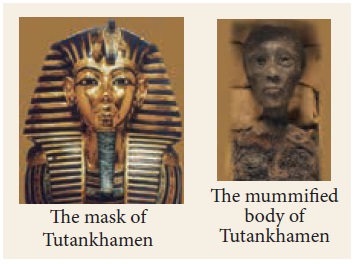
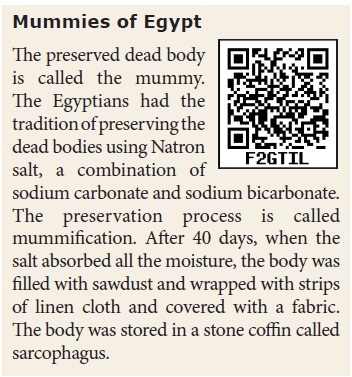
Viziers were the high officials who administered
territories under the direction of the Pharaohs.
The Egyptians believed in life after death. Therefore,
they preserved the dead body. The art of preserving the dead body is known as
mummification. Pyramids and tombs were built to preserve the body of pharaohs.
The famous Egyptian pharaoh Tutankhamen’s (who
ruled from 1332 to 1322 BCE) tomb with a rich variety of offerings is located
near Luxor in Egypt. The mask of his mummy made of gold and decorated with
precious stones is an important artefact of the Egyptian civilisation.
Agriculture and Trade
The Egyptians cultivated wheat, barley, millets, vegetables,
fruits, papyrus and cotton. Papyrus was used for making rope mats and sandals,
and later for producing paper. They domesticated cattle, sheep, goat and pigs,
and hunted wild animals. They had pets such as dogs, cats and monkeys. The
Egyptians had trade relations with Lebanon, Crete, Phoenicia, Palestine and
Syria. Gold, silver and ivory were imported, and they acquired the
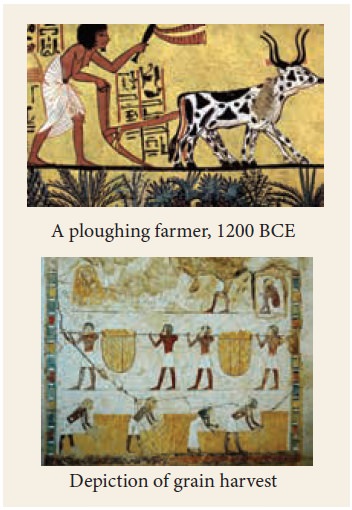
Lapis Lazuli, a precious stone of bluish colour,
from Afghanistan.
Art and Architecture
The Egyptians excelled in art and architecture.
Their writing is also a form of art. Numerous sculptures, painting and carvings
attest to the artistic skills of Egyptians.
The pyramids are massive monuments built as tombs
of mourning to the Pharaohs. The great pyramids near Cairo are known as the
Giza Pyramids. Pyramids are considered to be one of the wonders of the world,
and they were built between 2575 and 2465 BCE. These monuments display the
engineering, architectural and human resource management skills of the
Egyptians.
The Great Sphinx of Giza is a massive limestone image of a
lion with a human head. It is dated to the time of Pharaoh Khafre. It is one of
the largest sculptures of the world
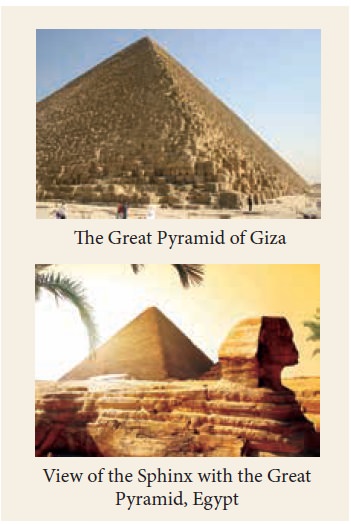
and measures seventy three metres in length and
twenty metres in height.
Religion
Egyptians practiced polytheism. Amon, Re, Seth,
Thoth, Horus and Anubis are some of the gods of Egyptians. They worshipped many
gods, but the Sun god, Re, was the predominant one. Later on, the Sun god was
called Amon. Amon was considered to be the king of gods. Anubis is the god of
death, related to embalming of the dead. He is considered the protector of the
dead and depicted with a jackal head. Thoth was the god of writing and
learning. He has the head of the bird, ibis.
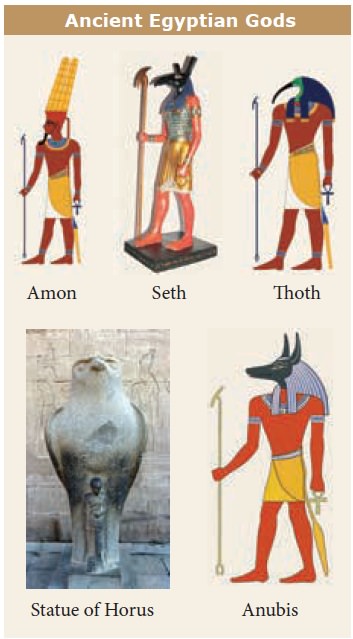
Philosophy, Science and Literature
Egyptian civilisation excelled in science,
literature, philosophy, astronomy, mathematics and the measurement system.
Sundial, water clock and glass were developed by the Egyptians. They devised a
solar calendar that consisted of twelve months of thirty days each, with five
days added to the end of a year. This calendar was introduced as early as 4200
BCE. Literary works included treatises on mathematics, astronomy, medicine,
magic and religion. The Egyptians also distinguished themselves in painting,
art, sculpture, pottery, music and weaving.
Writing System
Egyptians are well known for their writing system.
Their form of writing is known as hieroglyphic. Hieroglyphic was used in the
inscriptions on seals and other objects. The heretic, an another form of
writing, was used for common purposes. This form of writing used a
pictogram-based system. It was developed around 3000 BCE and many texts and
books were written using this script. The Egyptian writing system was
deciphered by the French scholar, Francois Champollion (1822 CE). He used the
Rosetta stone, a trilingual inscription, for deciphering the script. This
inscription, which was written in Hieroglyphic, Demotic and Greek, was taken to
France by Napoleon and from there it was taken to England. Now this inscription
is on display in the British Museum London.
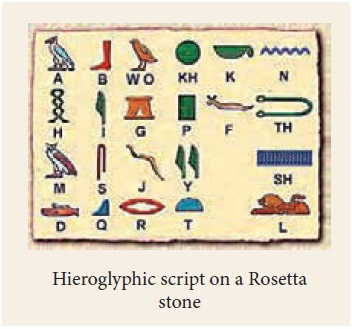
Characteristics and Contributions of the Egyptian Civilisation
·
Egyptians developed a solar calendar system.
·
The pyramids and their designs show their mathematical and surveying skills.
·
Hieroglyphic writing system attests to their skills in handling symbols.
·
Preservation of human body in the form of Mummies.
·
They applied innovation in the use of science and technology.
Related Topics